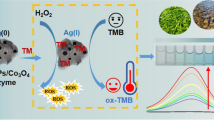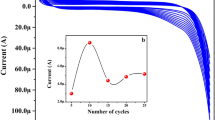Abstract
A poly(m-phenylenediamine)/sliver (PmPD/Ag) composite electrode was fabricated by in situ generation of solver particles on the surface of poly(m-phenylenediamine) (PmPD) matrix, and its electrochemical and amperometric non-enzymatic sensor performances were studied under the different electrolytes. And the characteristics of PmPD/Ag composite were also measured by scanning electron microscopy (SEM), ultraviolet visible (UV-vis) absorption spectrum, Fourier transform infrared spectroscopy (FTIR), and thermogravimetric analysis (TGA), respectively. The results of SEM indicated that the PmPD/Ag composite has been successfully prepared and the silver (Ag) particles were well dispersed on the surface of the PmPD matrix. And FTIR and UV-vis demonstrated that the introduction of Ag particles facilitated the charge transfer along the PmPD polymer chain, which is beneficial to the improvement of electrochemical performances. Furthermore, the electrochemical and sensor performances based on PmPD/Ag composite were investigated by cyclic voltammetry (CV) and amperometric i-t curve. The research results demonstrated that PmPD/Ag composite electrode in the alkaline environment showed an outstandingly electrochemical catalysis characteristic to glucose, such as a low detection limit of 7.2 μM, a wide linear range of 12.5 μM to 23.0 mM (R = 0.998), a short response time (within 3 s), and high sensitivity (1611.9 μA mM−1 cm−2) and stability (87% remains after 30 days). The constructed non-enzymatic sensor was one of the promising candidates due to its superior sensitivity, selectivity, and reproducibility.












Similar content being viewed by others
References
Bouchard J, Chornet E, Overend RP (1988) High-performance liquid chromatographic monitoring of carbohydrate fractions in partially hydrolyzed corn starch. J Agric Food Chem 36(6):1188–1192. https://doi.org/10.1021/jf00084a016
Barone PW, Parker RS, Strano MS (2005) In vivo fluorescence detection of glucose using a single-walled carbon nanotube optical sensor: design, fluorophore properties, advantages, and disadvantages. Anal Chem 77(23):7556–7562. https://doi.org/10.1021/ac0511997
Huang FY, Wang F, Feng SQ, Li Y, Li SX, Li YC (2013) Direct electrochemistry and electrochemical biosensing of glucose oxidase based on CdSe@CdS quantum dots and MWNT-modified electrode. J Solid State Electrochem 17(5):1295–1301. https://doi.org/10.1007/s10008-012-1986-y
Lee SR, Lee YT, Sawada K, Takao H, Ishida M (2008) Development of a disposable glucose biosensor using electroless-plated Au/Ni/copper low electrical resistance electrodes. Biosens Bioelectron 24(3):410–414. https://doi.org/10.1016/j.bios.2008.04.017
Liu L, Chen Y, Lv H, Wang G, Hu X, Wang C (2015) Construction of a non-enzymatic glucose sensor based on copper nanoparticles/ poly(o-phenylenediamine) nanocomposites. J Solid State Electrochem 19(3):731–738. https://doi.org/10.1007/s10008-014-2659-9
Chen XM, GH W, Cai ZX, Oyama M, Chen X (2014) Advances in enzyme-free electrochemical sensors for hydrogen peroxide, glucose, and uric acid. Microchim Acta 181(7-8):689–705. https://doi.org/10.1007/s00604-013-1098-0
Jeffrey DN, Anthony PFT (2005) Home blood glucose biosensors: a commercial perspective. Biosens Bioelectron 20:2435–2453
Donten W, Stojek Z (2012) Nanoparticles and nanostructured materials used in modification of electrode surfaces. ACS Symposium 26:313–325
Fan Z, Liu B, Liu X, Li Z, Wang H, Yang S, Wang J (2013) A flexible and disposable hybrid electrode based on Cu nanowires modified graphene transparent electrode for non-enzymatic glucose sensor. Electrochim Acta 109:602–608. https://doi.org/10.1016/j.electacta.2013.07.153
Veerappan G, Bojan K, Rhee SH (2011) Sub-micrometer-sized graphite as a conducting and catalytic counter electrode for dye-sensitized solar cells. ACS Appl Mater Interfaces 3(3):857–862. https://doi.org/10.1021/am101204f
Guo MQ, Hong HS, Tang XN, Fang HD, XH X (2012) Ultrasonic electrodeposition of platinum nanoflowers and their application in nonenzymatic glucose sensors. Electrochim Acta 63:1–8. https://doi.org/10.1016/j.electacta.2011.11.114
Cheng TM, Huang TK, Lin HK, Tung SP, Chen YL, Lee CY, Chiu HT (2010) (110)-exposed gold nanocoral electrode as low onset potential selective glucose sensor. ACS Appl Mater Interfaces 2(10):2773–2780. https://doi.org/10.1021/am100432a
Chen DJ, YH L, Wang AJ, Feng JJ, Huo TT, Dong WJ (2012) Facile synthesis of ultra-long Cu microdendrites for the electrochemical detection of glucose. J Solid State Electrochem 16(4):1313–1321. https://doi.org/10.1007/s10008-011-1524-3
Lu LM, Zhang L, Qu FL, Lu HX, Zhang XB, Wu ZS, Huan SY, Wang QA, Shen GL, Yu RQ (2009) A nano-Ni based ultrasensitive nonenzymatic electrochemical sensor for glucose: enhancing sensitivity through a nanowire array strategy. Biosens Bioelectron 25(1):218–223. https://doi.org/10.1016/j.bios.2009.06.041
Zhang YW, Wang L, Tian JQ, Li HL, Luo YL, XP S (2011) Ag@poly(m-phenylenediamine) core−shell nanoparticles for highly selective, multiplex nucleic acid detection. Langmuir 27(6):2170–2175. https://doi.org/10.1021/la105092f
Mehdil B, Amirhassan A, Samaneh F (2016) Development of non-enzymatic glucose sensor based on efficient loading Ag nanoparticles on functionalized carbon nanotubes. Sensors Acturors B-Chemical 225:354–362
Li H, Guo CY, CL X (2015) A highly sensitive non-enzymatic glucose sensor based on bimetallic Cu-Ag superstructures. Biosens Bioelectron 63:339–346. https://doi.org/10.1016/j.bios.2014.07.061
Ding Y, Wang Y, Su L, Zhang H, Lei Y (2010) Preparation and characterization of NiO–Ag nanofibers, NiOnanofibers, and porous Ag: towards the development of a highly sensitive and selective non-enzymatic glucose sensor. J Mater Chem 20(44):9918–9926. https://doi.org/10.1039/c0jm01968b
Rao C, Kulkarni G, Thomas P, Edwards P (2000) Metal nanoparticles and their assemblies. Chem Soc Rev 29(1):27–35. https://doi.org/10.1039/a904518j
Chang G, Luo Y, Lu W, Qin X, Asiri AM, Al-Youbi AO, Sun X (2012) Ag nanoparticles decorated polyaniline nanofibers: synthesis, characterization, and applications toward catalytic reduction of 4-nitrophenol and electrochemical detection of H2O2 and glucose. Catalysis Sci Technol 2(4):800–806. https://doi.org/10.1039/c2cy00454b
Qin X, Lu W, Luo Y, Chang G, Asiri AM, Al-Youbi AO, Sun X (2012) Synthesis of Ag nanoparticle-decorated 2,4,6-tris(2-pyridyl)-1,3,5-triazine nanobelts and their application for H2O2 and glucose detection. Analyst 137(4):939–943. https://doi.org/10.1039/C2AN15996A
Liu S, Tian J, Wang L, Sun X (2011) Microwave-assisted rapid synthesis of ag nanoparticles/graphene nanosheet composites and their application for hydrogen peroxide detection. J Nanopart Res 13(10):4539–4548. https://doi.org/10.1007/s11051-011-0410-3
Tian J, Luo Y, Li H, Lu W, Chang G, Qin X, Sun X (2011) Ag@poly(mphenylenediamine)-Ag core-shell nanoparticles: one-step preparation, characterization, and their application for H2O2 detection. Catalysis Sci Technol 1:1393–1398
Liu S, Wang L, Tian J, Luo Y, Zhang X, Sun X (2011) Aniline as a dispersing and stabilizing agent for reduced graphene oxide and its subsequent decoration with Ag nanoparticles for enzymeless hydrogen peroxide detection. J Colloid Interface Sci 363(2):615–619. https://doi.org/10.1016/j.jcis.2011.07.083
Cao F, Guo S, Ma HY, Shan DC, Yang SX, Gong J (2011) Nickel oxide microfibers immobilized onto electrode by electrospinning and calcination for nonenzymatic glucose sensor and effect of calcination temperature on the performance. Biosens Bioelectron 26(5):2756–2760. https://doi.org/10.1016/j.bios.2010.10.013
Babu TGS, Ramachandran T, Nair B (2010) Single step modification of copper electrode for the highly sensitive and selective non-enzymatic determination of glucose. Microchim Acta 169(1-2):49–55. https://doi.org/10.1007/s00604-010-0306-4
Yang J, Zhang WD, Gunasekaran SD (2010) An amperometric non-enzymatic glucose sensor by electrodepositing copper nanocubes onto vertically well-aligned multi-walled carbon nanotube arrays. Biosens Bioelectron 6:279–284
Li LH, Zhang WD (2008) Preparation of carbon nanotubes supported platinum nanoparticles by an organic colloidal process for nonenzymatic glucose sensing. Microchim Acta 163(3-4):305–311. https://doi.org/10.1007/s00604-008-0016-3
He H, Zhu J, Tao NJ, Nagahara LA, Amlani I, Tsui R (2001) A conducting polymer nanojunction switch. J Am Chem Soc 123(31):7730–7731. https://doi.org/10.1021/ja016264i
Shipway AN, Katz E, Willner I (2000) Nanoparticle arrays on surfaces for electronic, optical, and sensor applications. ChemPhysChem 1(1):18–52. https://doi.org/10.1002/1439-7641(20000804)1:1<18::AID-CPHC18>3.0.CO;2-L
Kraft A (2001) Organic field-effect transistors-the breakthrough at last. ChemPhysChem 2(3):163–165. https://doi.org/10.1002/1439-7641(20010316)2:3<163::AID-CPHC163>3.0.CO;2-V
Holtz JH, Asher SA (1997) Polymerized colloidal crystal hydrogel films as intelligent chemical sensing materials. Nature 389(6653):829–832. https://doi.org/10.1038/39834
Pernaut JM, Reynolds JR (2000) Use of conducting electroactive polymers for drug delivery and sensing of bioactive molecules. J Phys Chem B 10:44080–44090
Leng H, Wu W (2012) Synthesis of a novel fluorine-based conjugated polymer with pendent bulky caged adamantane moieties and its application in the detection of trace DNT explosives. Reactive Functional Polymers 72:206–211
Akhtar P, Too CO, Wallace GG (1997) Detection of amino acids at conducting electroactive polymer modified electrodes using flow injection analysis, part I. Use Macroelectrodes, Analytica Chimica Acta 339(3):201–209. https://doi.org/10.1016/S0003-2670(96)00477-1
Choong CL, Milne WI (2010) Dynamic modulation of detection window in conducting polymer based biosensors. Biosens Bioelectron 25(10):2384–2388. https://doi.org/10.1016/j.bios.2010.03.023
Chirizzi D, Malitesta C (2011) Potentiometric urea biosensor based on urease immobilized by an electrosynthesized poly(o-phenylenediamine) film with buffering capability. Sensors Acturors B-Chemical 157(1):211–215. https://doi.org/10.1016/j.snb.2011.03.051
Wang Z, Liao F (2012) Fluorescent probes for Pd2+ detection by poly(o-phenylenediamine) nanospheres with fluorescence enhancement. Synth Met 162(5-6):444–447. https://doi.org/10.1016/j.synthmet.2012.01.013
Guimard NK, Gomez N, Schmidt CE (2007) Conducting polymers in biomedical engineering. Prog Polym Sci 32(8-9):876–921. https://doi.org/10.1016/j.progpolymsci.2007.05.012
Gerard M, Chaubey A, Malhotra BD (2002) Application of conducting polymers to biosensors. Biosens Bioelectron 17(5):345–359. https://doi.org/10.1016/S0956-5663(01)00312-8
Huang MR, Peng QY, Li XG (2006) Rapid and effective adsorption of lead ions on fine poly(phenylenediamine) microparticles. Chemistry-A European J 12(16):4341–4350. https://doi.org/10.1002/chem.200501070
Zhang LY, Chai L, Liu J, Wang H, Yu W, Sang P (2011) pH manipulation: a facile method for lowering oxidation state and keeping good yield of poly(m-phenylenediamine) and its powerful Ag+ adsorption ability. Langmuir 27(22):13729–13738. https://doi.org/10.1021/la203162y
Raveendran P, Fu J, Wallen SL (2003) Completely “green” synthesis and stabilization of metal nanoparticles. J Am Chem Soc 125(46):13940–13941. https://doi.org/10.1021/ja029267j
Dallas P, Niarchos D, Vrbanic D, Boukos N, Pejovnik S, Trapalis C, Petridis D (2007) Interfacial polymerization of pyrrole and in situ synthesis of polypyrrole/silver nanocomposites. Polymer 48(7):2007–2013. https://doi.org/10.1016/j.polymer.2007.01.058
Wang JX, Wang MR, Guan J, Wang CY, Wang GX (2017) Construction of a non-enzymatic sensor based on the poly(o-phenylenediamine)/Ag-NPs composites for detecting glucose in blood. Mater Sci Eng C 71:844–851. https://doi.org/10.1016/j.msec.2016.10.080
Maurício APP, Fabio RC, Márcio FB, Luiz HMJ (2017) Facile synthesis of a silver nanoparticles/polypyrrole nanocomposite for non-enzymatic glucose determination. Mater Sci Eng C 75:88–94
Hoa LT, Linh NTY, Chung JS, Hur SH (2017) Green synthesis of silver nanoparticle-decorated porous reduced graphene oxide for antibacterial non-enzymatic glucose sensors. Ionics 23(6):1525–1532. https://doi.org/10.1007/s11581-016-1954-0
Acknowledgments
This work was supported by the analysis and testing foundation of Zhejiang University of Technology.
Funding
The authors gratefully thank the National Science Foundation of China (Grant No. 51573099), the Natural Science Foundation of Liaoning Province, China (Grant No. 2015020441, No. 201602591), the National Science Foundation for Post-doctoral Scientists of China (Grant No. 2015M570524), Liaoning Provincial Key Laboratory Construction Project (Grant No. LZ2016005) for financial support.
Author information
Authors and Affiliations
Corresponding authors
Electronic supplementary material
ESM 1
(DOC 293 kb)
Rights and permissions
About this article
Cite this article
Xu, L., Ma, J., Zhou, N. et al. Well-dispersed poly(m-phenylenediamine)/silver composite for non-enzymatic amperometric glucose sensor applied in a special alkaline environment. Ionics 24, 2795–2805 (2018). https://doi.org/10.1007/s11581-017-2405-2
Received:
Revised:
Accepted:
Published:
Issue Date:
DOI: https://doi.org/10.1007/s11581-017-2405-2




